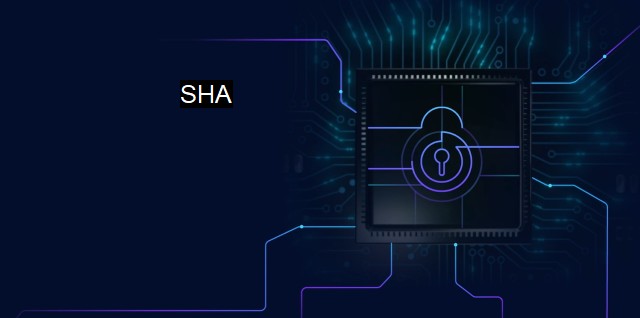What is SHA?
The Power of Secure Hash Algorithm: SHA in Cybersecurity and Cryptographic Applications
Secure Hash Algorithms (SHA) refers to a set of cryptographic hash functions designed by the National Security Agency (NSA) and published by the National Institute for Standards and Technology (NIST). You can think of them like unique digital fingerprints, calculated through complex cryptographic algorithms applied to your data — be it a password, a message, or an email.SHA algorithms are integral parts of cybersecurity systems, ensuring security, integrity, and authenticity of data transmitted online. In an era where data breaches are common and widespread, having robust cybersecurity measures in place like SHA is vital.
These algorithms work by taking data inputs and computing a hash value, a type of digital signature for the data. An important aspect of a secure hash function is the immutability of this hash value. Despite significant manipulations to the original data, the hash will always compute to the same value. This makes hashing highly beneficial for integrity checks — if the hash value changes, it means the data has likely been altered or compromised.
Comparing hash values becomes a convenient and efficient method of comparing data, especially in antivirus software applications. an antivirus software might keep a database of the hash values of known malicious software. When the antivirus scans your computer, it checks the hash values of files against its database. If there’s a match, it flags the file as possibly harmful.
SHA functions fall into several categories, primarily distinguished by the length of the hash produced. The most commonly used today are SHA-2 and SHA-3 families. The older SHA-1 algorithm has shown vulnerabilities and is being progressively phased out in favor of its successors.
Even the seemingly invincible nature of SHA isn’t without its weaknesses. One area of concern is "collision attacks" – scenarios in which two sets of distinct data produce the same hash value. Collision attacks defy the fundamental property of a hash function, which states that each input should have a unique hash value. The year 2005 witnessed successful collision attacks on SHA-1, leading cybersecurity experts to recommend quick migration to stronger algorithms like SHA-256 or even SHA-3 for enhanced protection.
In SHA-2, six separate hash functions each produce hash values of different lengths, the most commonly used being SHA-256 and SHA-512. While collision vulnerabilities were noted with SHA-1, these issues have yet to be found in SHA-2, making it a safer choice for data security.
In 2012, SHA-3 was introduced, which was an entirely different algorithm from its antecedents. SHA-3 provides the same capabilities as SHA-2 but with a more reliable structure and heightened performance. Its different approach to hashing also means that even if a vulnerability were found in SHA-2, it would not necessarily extend to SHA-3, providing another level of protection.
No matter how sophisticated and reliable these algorithms may become, they are not stand-alone solutions to ensuring data integrity and security. Complementary measures such as secure communication protocols, strong access control mechanisms, and continuous monitoring and detection systems are equally essential to a comprehensive cybersecurity strategy.
SHA, therefore, remains just one pillar in the greater landscape of cybersecurity defense methodologies. Its appropriate implementation in tandem with other well-devised cybersecurity tools can significantly enhance the overall security of a system, driving minimized risks and a more secure environment. As cyber threats evolve, SHA, too, will adapt and continue playing a fundamental part in safeguarding our digital ecosystems.

SHA FAQs
What is SHA-1?
SHA-1 (Secure Hash Algorithm 1) is a cryptographic hash function that produces a 160-bit digest (hash value) from any input data. It is commonly used in digital signatures, message authentication codes, and other cryptographic applications.Why is SHA-1 considered insecure?
SHA-1 is considered insecure because it is vulnerable to collision attacks, where two different inputs can produce the same hash value. This means that an attacker could create a fraudulent message with the same hash value as a legitimate message, leading to security breaches and other malicious activities.What is SHA-256?
SHA-256 (Secure Hash Algorithm 256) is a cryptographic hash function that produces a 256-bit digest from any input data. It is considered more secure than SHA-1 and is commonly used in digital certificates, SSL/TLS encryption, and other security protocols.How does antivirus software use SHA to detect malware?
Antivirus software uses SHA to detect malware by calculating the hash value of the files on a computer and comparing them against a database of known malicious hashes. If a file's hash matches a known malicious hash, the antivirus software will flag it as malware and take appropriate action to quarantine or remove the file. This helps to protect the computer against malware and other security threats.| | A | | | B | | | C | | | D | | | E | | | F | | | G | | | H | | | I | | | J | | | K | | | L | | | M | |
| | N | | | O | | | P | | | Q | | | R | | | S | | | T | | | U | | | V | | | W | | | X | | | Y | | | Z | |
| | 1 | | | 2 | | | 3 | | | 4 | | | 7 | | | 8 | | |||||||